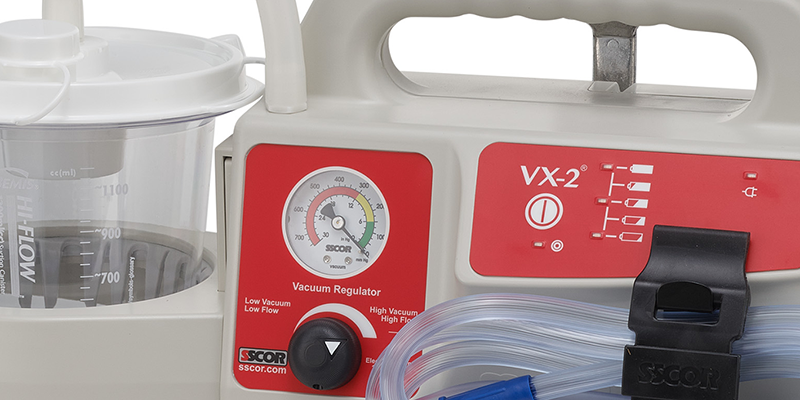
Quickly and efficiently hooking up your portable suction machine can save precious seconds, preventing hypoxia and reducing the risk of serious respiratory complications. It should only take a few seconds, but if you’ve never done it before, the process can feel overwhelming and frustrating.
Your team must regularly drill the process, particularly if using suction machines is an infrequent part of your job and team members have little practice. Here are the basic steps for getting your machine ready to go.
1. Practice Proper Storage
Hooking up your suction machine begins well before you need it. Store your suction machine so it is always ready for use and doesn’t require fumbling through a pile of supplies or connecting loose parts. Some important maintenance and storage tips include the following:
- Store the suction machine in your tactical kit so that it’s ready to go for emergencies.
- Keep attachments of various sizes in the kit with the machine so that you have the tubing and catheters you need.
- Throw away any attachments that are broken or that do not fit the machine. Hanging onto outdated tubing from an old machine only means you will spend more time fumbling for the right equipment.
- Keep all parts of the unit attached and avoid storing it in a location where it will be frequently jostled. If you keep the unit in an ambulance, check that the parts are securely attached at the beginning and end of each workday.
- Keep your suction machine plugged in and on charge when not in use. If possible, arrange for power to the machine even when the vehicle is turned off and parked or moving. If this is not possible, make sure the device spends at least several hours per day charging.
2. Test the Machine
Testing your suction machine every day takes only a few seconds but can ensure that life-saving equipment is available when needed. Testing the equipment each morning also affords you the chance to ensure that all connections are tight and that you have all the attachments you may need. available when you need it
3. Keep Extra Batteries on Hand
It’s a terrifying moment: You have a child who is suffering from respiratory distress. You go to hook up your machine, but it won’t start. The battery has died or expired, and you don’t have an extra one on hand. Batteries are just as important as the machine itself. When you test the machine each morning, you’ll verify that the battery works.
4. Attach Clean, Properly Fitted Parts
People in respiratory distress face a higher risk of infection and may be less equipped to fight off any infection they contract. Keeping the machine clean may be a matter of life and death. Disinfect the machine after each use, and throw away parts that are intended only for single use.
Before you suction a patient, put on clean gloves before touching any part of the machine that comes into contact with the patient. Secure all connections, and select the catheter size appropriate for the patient. Note that in most cases, pediatric and geriatric patients will require smaller catheters and may benefit from more flexible tubing.
5. Suction the Patient
Only suction a patient who shows clear indications for suctioning. If such indications are present, do not delay treatment. Check the suction machine again to ensure it is properly assembled, then quickly and compassionately explain the procedure to the patient.
Proceed with suctioning. In the case of tracheal suctioning, never suction for longer than 15 seconds; if the first suctioning attempt fails, withdraw the suction tip and try again because prolonged suctioning increases the risk of hypoxia.
The right suction machine offers years of use without failing or losing suctioning power. This saves money and resources, not to mention lives. For help finding and purchasing the right portable suction machine for your organization, download our free e-book, The Ultimate Guide to Purchasing a Portable Emergency Suction Device.
Editor's Note: This blog was originally published in July, 2023. It has been re-published with additional up to date content.
















